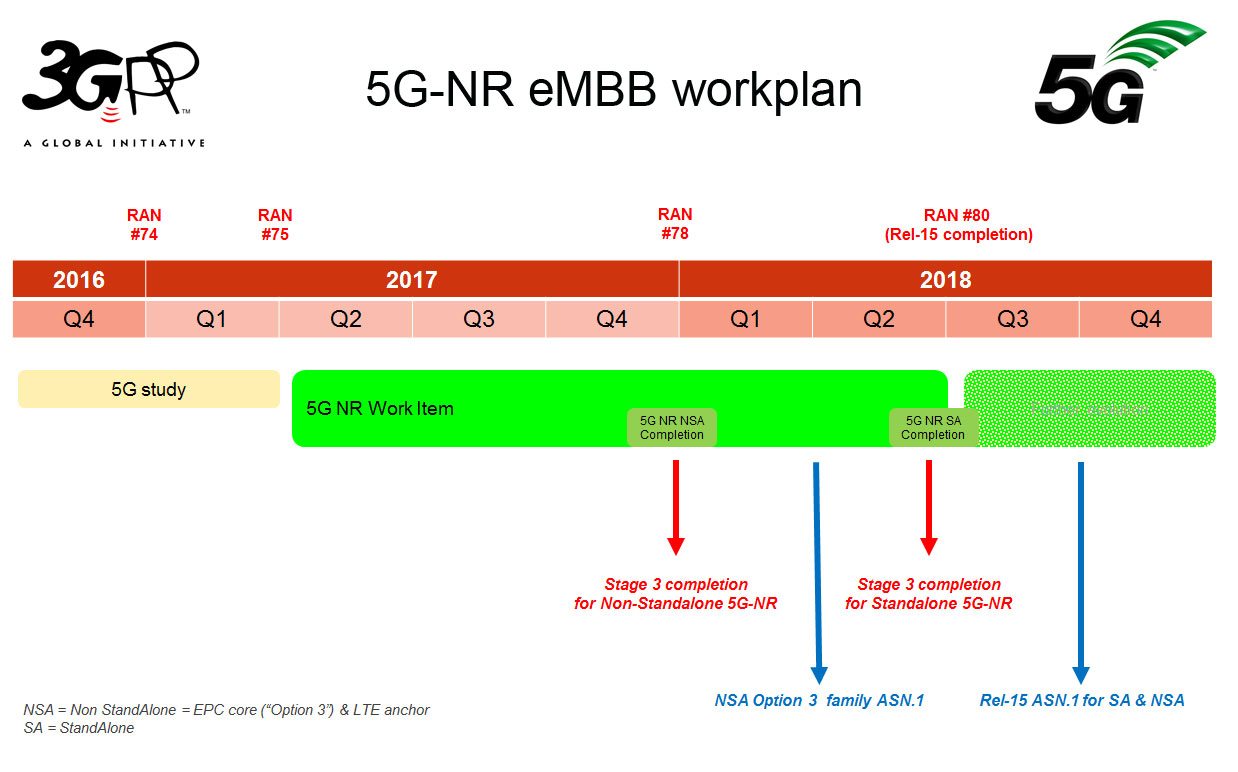Standards-based 5G networks could begin hitting the market as soon as year-end, with AT&T touting mobile 5G services by end of 2018.
Proponents of an accelerated standards timeline for a non-standalone “5G” specification were successful in getting the Third Generation Partnership Project to approve plans that could see standards-based mobile 5G services launched by the end of next year.
During a recent plenary meeting in Croatia, 3GPP said it agreed to work towards the non-standalone 5G New Radio mode in support of mobile broadband services to be finalized by March 2018. The standard will require an anchored LTE deployment with the 5G NR carriers used to boost throughput speeds and cut network latency.
The accelerated timeline is also expected to see some standards components needed for the development of supporting chipsets released by the end of this year.
As for a standalone 5G option, which would not require the need for an already deployed LTE network core, 3GPP said it remained committed to completing a standard by September 2018. The 5G-specific core is expected to include a greater use of software virtualization technologies like software-defined networking, network functions virtualization and network slicing.
In terms of 3GPP’s release schedules, the initial 5G-related Release 15 specification is expected to be completed by mid-2018. The more fully formed Release 16 specification, which is set to include a focus on internet of things deployments, reliability and latency, is now expected to be ready by the end of 2019.
The Release 16 timing would seem to continue backing previous claims of true 5G networks being deployed commercially beginning in 2020.

The push behind an accelerated standards timeline for the non-standalone option gained significant progress during the meeting with the inclusion of former opponents Verizon Communications and Samsung, both of which had previously lobbied for 3GPP to stick to its original timeline of mid-2018. Verizon last month said it planned to roll out fixed wireless 5G trials in 11 markets this year with the help of network partners, including Samsung and Ericsson.
A recent report from Signals Research Group out of the 3GPP meeting did note one of the concerns on the accelerated proposal was over interoperability between the initial standard and the official Release 15 specifications, with both sides wanting “to allow for backward incompatible change requests post March 2018 without implying that there would likely be an incompatible version of Release 15 (NSA only) in December 2018.” It’s been reported that some of the early 5G-based fixed wireless broadband deployments might use technology that would not be interoperable with what is expected to be a finished 5G standard.
The 3GPP meeting also resulted in the organization codifying current work on what is expected to become the 5G standard under the 5G label, which means 3GPP will use the term for all Release 15 and consequent release work. However, SRG President and Founder Michael Thelander did add that official “G” designations are handled by the International Telecommunications Union, which is not expected to proclaim a true 5G standard until 3GPP makes its Release 16 submission to the ITU.
AT&T on board
AT&T came out as strong supporters of the 3GPP decision, with the carrier stating it was now preparing to launch a standards-based mobile 5G service as soon as late 2018, or a claimed year ahead of its previous schedule.
“Making the bold vision for 5G a reality will take the collective industry’s unified backing,” wrote Andre Fuetsch, CTO and president of AT&T Labs, in a blog post. “We’ve been working for years alongside dozens of major industry players to ensure we’re all aligned on 5G standards, including the new accelerated timeline. We’ve seen with past generations of wireless networks how some companies will launch proprietary technology in the race to be first and then later have to backtrack. This leaves customers with potentially obsolete phones and gear. We don’t see how that approach benefits customers.”
AT&T recently moved its 5G plans under the “Network 3.0 Indigo” banner, which also includes its current work in enhancing its LTE network. The carrier said it plans to launch its first “5G Evolution markets” in the coming months in Indianapolis and Austin, Texas, with those test beds to include dedicated outdoor and indoor testing locations that will include “flexible infrastructure to allow modifications and updates as 5G standards develop,” and include spectrum support below 6 GHz, and in the 28 GHZ and 39 GHz bands.
The carrier said initial wireless services are expected to support speeds up to 400 megabits per second, with up to one gigabit per second expected by year-end as it folds in more support from network densification, carrier aggregation and license assisted access technologies.
Bored? Why not follow me on Twitter.

